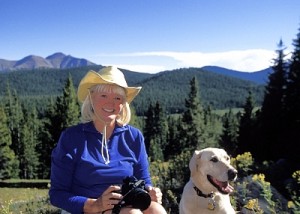Brief by Martha Quillen
Regional News – June 2005 – Colorado Central Magazine
Augusta Leaves for Better Climes
Melva Touchette has been performing her one-woman impression of Baby Doe Tabor locally for 17 years, but The Herald Democrat recently reported that she’s leaving for Kansas “because her health is failing from the altitude.” Under the headline “Touchette takes ‘Baby Doe’ to lower elevations” the Leadville paper explained how Touchette first thought of re-enacting Baby Doe Tabor’s version of historical events for her Masters degree thesis in theater at the University of Arizona.

Whereupon Touchette’s professor decided that she should visit Leadville to see where it all happened, but Touchette never seemed to have the money and didn’t make it until 1987. Since then Touchette has been Baby Doe at the Tabor Opera House, the old church, the Apple Blossom Inn and for “at least eight seasons at the Healy House,” performing two to three nights a week every summer.
Touchette told The Herald Democrat that she loves the people and the town of Leadville, and really didn’t want to leave, but she hopes to continue her re-enactment of Baby Doe in Kansas.
Tank Preservation
Sargents is an old railroad town, as demonstrated by its major landmark – a water tank that hasn’t filled a locomotive tender in the nearly 50 years since the narrow-gauge line over Marshall Pass was abandoned by the Denver & Rio Grande Western Railroad.
Though it still stands, the tank is in poor condition – but it will be preserved, thanks to its new owners, Stan and Susan Esty. They’re joining with the Upper Tomichi Historical and Community Association to save the tank; donations are tax-deductible, and can go to UTHCA Water Tank Fund, P.O. Box 104, Sargents CO 81248.
Sargents sits halfway between Gunnison and Salida. It was a busy station during the narrow-gauge days as the westbound steam-powered trains required helper locomotives to climb the pass from 1881 to 1954. One water tank from Marshall Pass has been preserved at the Gunnison Pioneer Museum. There’s another surviving D&RG water tank at South Fork.
Potent Pond
On May 19, The Leadville Herald Democrat reported “A stinky issue has resurfaced again this year,” under the headline “If it looks like sewage, and it smells like sewage…”
Yes, it was sewage. In fact, a “pond of raw sewage” formed, due to an overflow of a ground absorption sewage system at a trailer park. Sewage overflows and other health and safety problems have been recurrent at that park, though.
According to a spokesmen for the building department, an order was drafted five years ago to require all tenants to leave, but it was stopped. And that same park was cited for violations last year, whereupon the county issued a resolution requiring improvements. Two out of three were met. Although the owner removed doors from abandoned refrigerators as requested, he failed to board up abandoned trailers. He also fenced the sewage lagoon as required, but he used wire fencing rather than “snow fencing.”
This time around, the owner has agreed to remove abandoned trailers and refrigerators, and the County wants a timeline from an engineer for the completion of a new sewage system — or else. According to the County Treasurer the “trailers have been delinquent on taxes since 1998, which would give the county a right to cancel the taxes in order to have the trailers removed.”
The Herald story concluded with a quote by County Commission Chair Ken Olsen, “The patience of the county is coming to an abrupt end.”
Cottonwood Saga Continues
Gunnison County won another round with the Federal Highway Administration (FHWA), and so its side of Cottonwood Pass will remain unpaved, even though the east side in Chaffee County has been paved for years.
Gunnison has long opposed pavement, arguing that any available federal money should go to the Taylor River Road between Gunnison and Crested Butte. The feds, however, have previously tied Taylor funds to Cottonwood paving, telling the county it can’t have one without the other.
But in early May, the FHWA committed to finish improvements on the Taylor River Road, with about $4 million available in 2007, and another $6 million in 2011. However, Gunnison County will work with the U.S. Forest Service to make some repairs on Cottonwood – shoring up shoulders and clearing trees from blind corners.
Oh, Well….
Results of a U.S. Geological Survey which tested Colorado streams and groundwater for chemicals were not encouraging, according to the April 18 High Country News. Researchers took samples from 15 urban streams, one forested stream, and 90 municipal and domestic wells. As expected the urban streams had the greatest concentration of chemicals, but the forested stream also contained low levels of 11 chemicals, including disinfectants, artificial fragrances, and insect repellents.
Because these chemicals come from human usage, experts didn’t expect to find so many in a forest stream. (Although the headline said pharmaceuticals and pesticides had turned up in streams and wells, the HCN story said curiously little about what was in wells — which just may encourage the idea that environmentalists care more about wildlife than people).
Pharmaceuticals and personal care products (or PPCPs) are apparently showing up in water because they’re not eliminated by “state-of-the-art “wastewater treatment systems. And that’s starting to concern scientists.
Determining the effects of small concentrations of such products is a “very tricky business,” but HCN detailed concerns about synthetic hormones and antidepressants. A government laboratory found that male trout exposed to low levels of estrogen were half as fertile as trout in estrogen-free water. David Norris, a CU physiologist studying sex ratios of white suckers, noted that fish downstream from treatment plants tend to be overwhelmingly female, and he has also observed abnormally high numbers of “intersex” fish. And Bryan Brooks, a Baylor University professor in Texas, is worried that high concentrations of the active ingredient in Prozac might effect fish functions – such as eating and reproduction.
But “regulation of low concentrations of PPCPs in the environment isn’t likely to happen soon,” HCN reported. So the studies continue….
Strange Days
The front page news in the May Crestone Eagle was so unusual, we thought maybe we’d picked up the April edition. But apparently they weren’t fooling, a tornado was seen in Crestone, the first ever, on April 24. Tornados are rare in the San Luis Valley, but do occur occasionally, although never before in Crestone.
When the May Eagle went to press, the National Weather Service office in Pueblo was still investigating the “possible tornado.” But the funnel cloud was photographed, and caught on video, and it was described as a “rare cold air funnel tornado,” by Marty Coniglio of 9 News.
The Eagle’s other front-page story reported that the remains of a Native American woman had been found during road work in the Baca Grants. “With the skeleton were two manos and one metate and an animal bone tool found loose in the dirt. Manos and metates are grinding stones used to process plants and other materials.”
State Archæologist Susan Collins indicated that the bones were thought to be 300 to 400 years old, and the woman was about 30 at the time of her death. Authorities will try to determine tribal affiliation so that the woman can be buried by her people in accordance with the Native American Graves Protection and Repatriation Act.
Mountain Sunset
The cover of the June edition of Sunset magazine touted the “Ultimate Colorado road trip.” Since the original meaning of ultimate is “final” or “last,” we thought it might refer to a canyon plunge in a vehicle.
But instead it was a drive around the state, interspersed with rock climbing, horseback rides, raft trips, and the like. This one started in Boulder and ended in Buena Vista, via Rocky Mountain National Park, Leadville, Aspen, Crested Butte, Durango, and the San Luis Valley. From the Sand Dunes, they headed to Buena Vista, but “I got lost that night. We have to backtrack over a mountain pass, arriving at the motel after midnight for a 7 a.m. wake-up.” So just how do you take the wrong pass from the Sand Dunes to Buena Vista? Sometimes the adventures that don’t make it into magazine stories sound more interesting than the ones that do.
[Bodie, the new Central security system] [Flower Power joins Pedal Power in downtown Salida] Subscribe to


